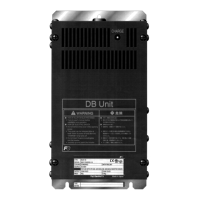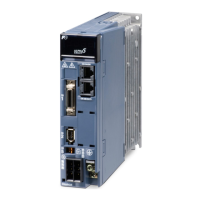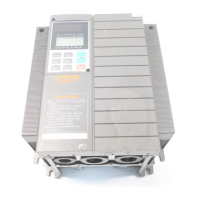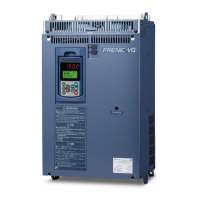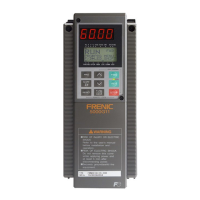5-32
Applicable Motor Rating and Characteristic Factors when P99 (Motor selection) = 0 or 4
Switching frequency
for motor
characteristic factor
Characteristic factor
(%)
Applicable
motor rating
(HP)
Thermal time
constant τ
(Factory default)
Output current for
setting the thermal
time constant
(Imax)
f
2 f3 α1 α2 α3
1/2, 1 75 85 100
2 to 5
7 Hz
85 85 100
7.5 to 15 6 Hz 90 95 100
20 7 Hz 85 85 100
25, 30
5 min 5 Hz
5 Hz 92 100 100
40 to 60 54 85 95
75 to 125 51 95 95
150 or above
10 min
Rated current
× 150%
Base
frequency
× 33%
Base
frequency
× 83%
53 85 90
Applicable Motor Rating and Characteristic Factors when P99 (Motor selection) = 1 or 3
Switching frequency
for motor
characteristic factor
Characteristic factor
(%)
Applicable
motor rating
(HP)
Thermal time
constant τ
(Factory default)
Output current for
setting the thermal
time constant
(Imax)
f
2 f3 α1 α2 α3
1/4 to 30 5 min
Base
frequency
× 33%
69 90 90
40 to 60 54 85 95
75 to 125 51 95 95
150 or above
10 min
Rated current
× 150%
Base
frequency
× 33%
Base
frequency
× 83%
53 85 90
Overload detection level (F11)
F11 specifies the level at which the electronic thermal overload protection becomes activated.
In general, set F11 to the rated current of motor when driven at the base frequency (i.e. 1.0 to 1.1
multiple of the rated current of motor (P03)). To disable the electronic thermal overload protection,
set F11 to "0.00: Disable."
Thermal time constant (F12)
F12 specifies the thermal time constant of the motor. The time constant is the time until the
electronic thermal overload protection detects the motor overload while the current of 150% of
the overload detection level specified by F11 has flown. The thermal constants of most
general-purpose motors including Fuji motors are set at about 5 minutes for capacities of 25HP
for 208V, 30HP for 460V or below or about 10 minutes for capacities of 30HP for 208V, 40HP for
460V or above by factory default.
(Example) When function code F12 is set at "5.0" (5 minutes)
As shown below, the electronic thermal overload protection is activated to detect an alarm
condition (alarm code
0l1
) when the output current of 150% of the overload detection level
(specified by F11) flows for 5 minutes, and 120% for approx. 12.5 minutes.
The actual driving time required for issuing a motor overload alarm tends to be shorter than the
value specified as the time period from when the output current exceeds the rated current
(100 %) until it reaches 150 % of the overload detection level.

